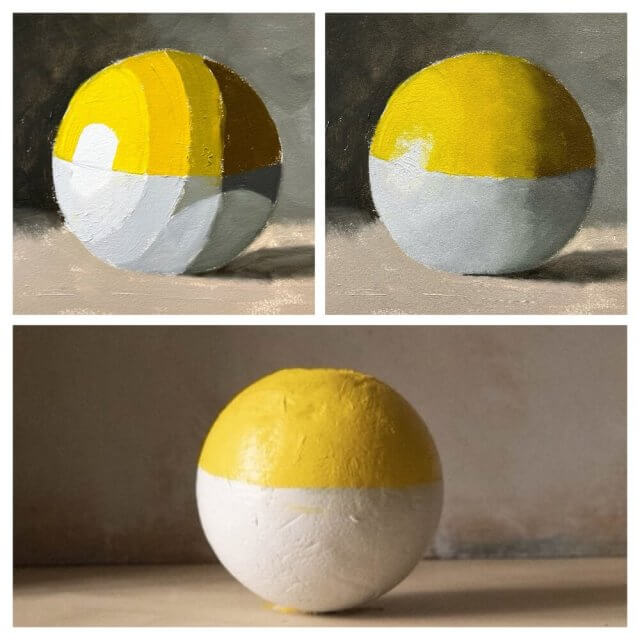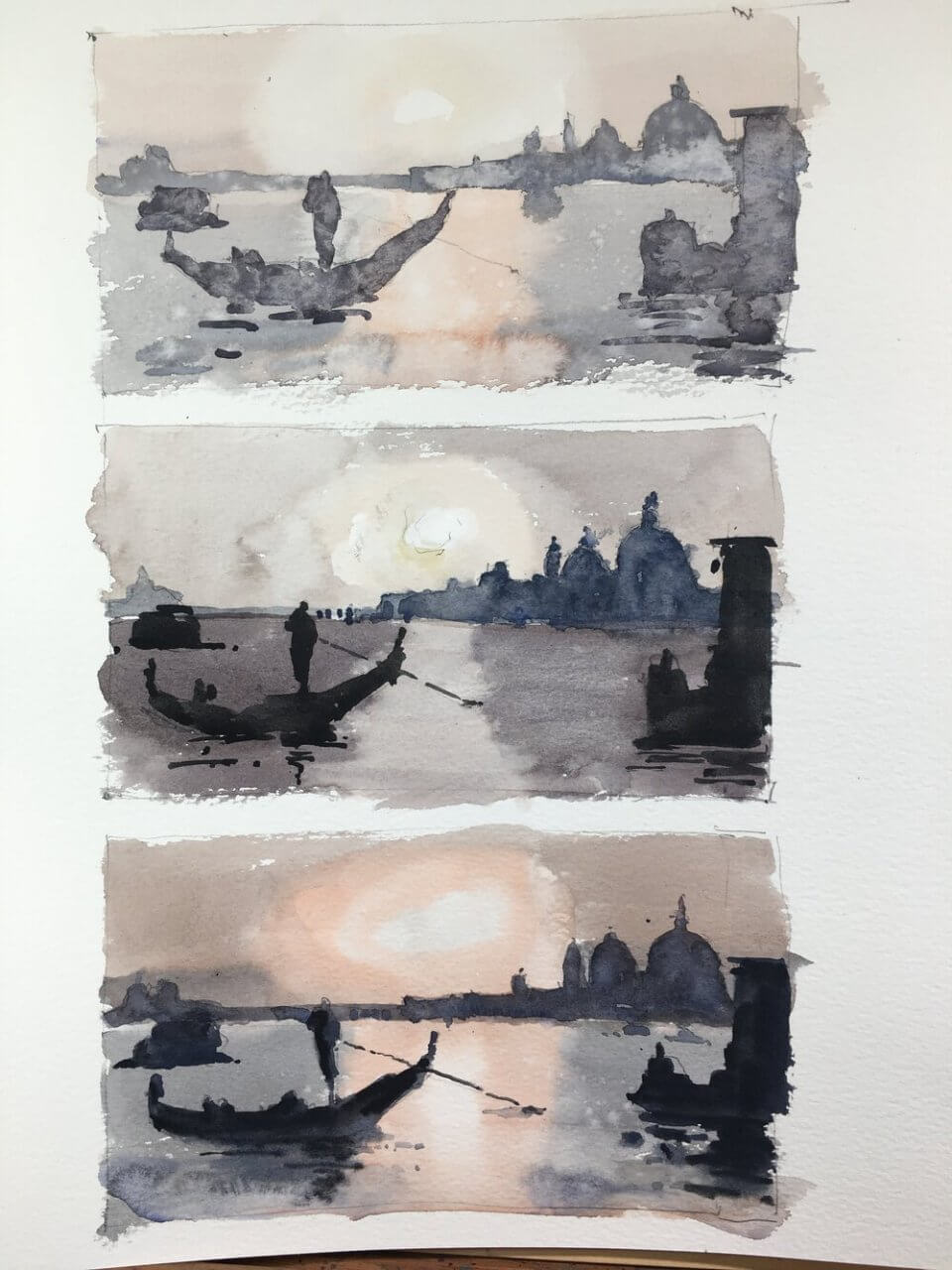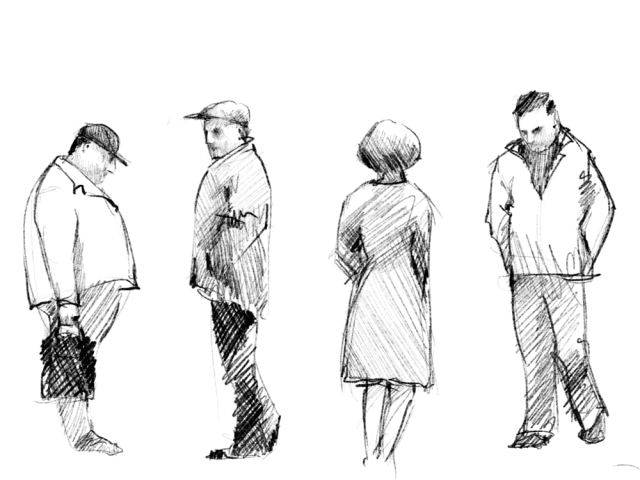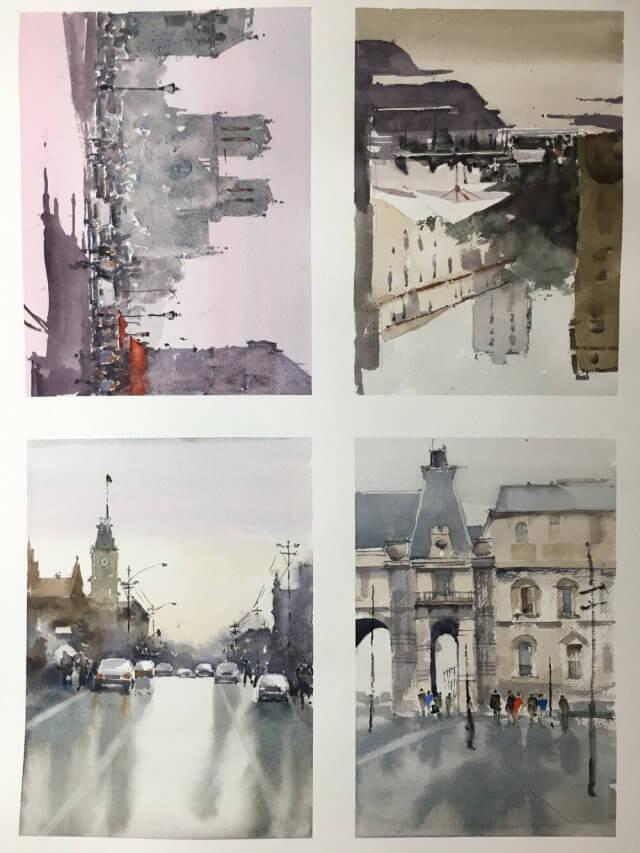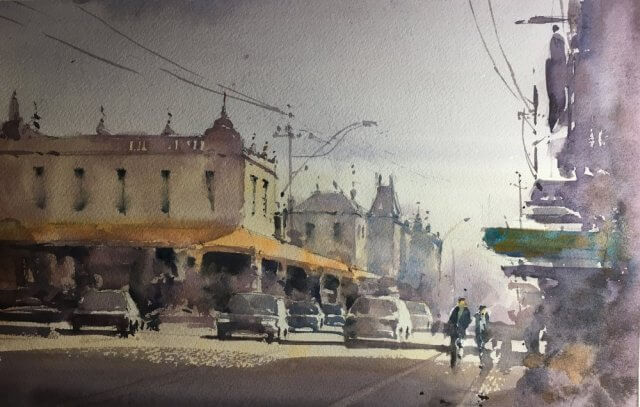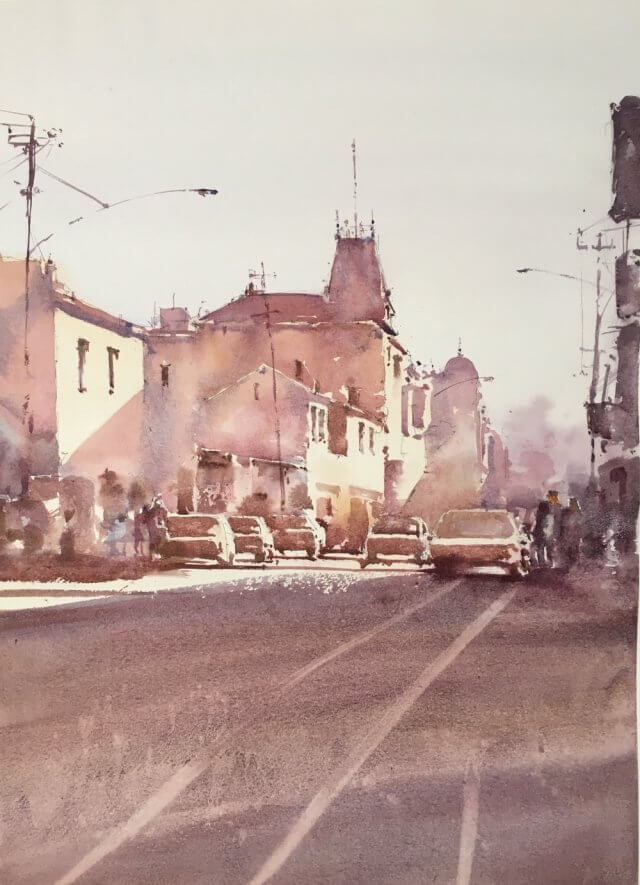Category: Exercises
Venice and Watercolor Value Studies
Varying the value range alters a painting’s feel
The plan behind venice and watercolor value studies is the following. Take a reference and paint it three times. The middle one is painted as closely to the actual value range in the reference as possible. The top one is shifting and compressing the value range to the top i.e. lighter than the reference. And similarly the bottom one is shifting and compressing the value range to the bottom i.e. darker.
Change the values but keep the value relationships
The first goal with these studies was to see whether we could shift the values but still keep the value relationships. If the relationships are good then the scene will read correctly. And I think they all do. None of them are great paintings but you can see they all represent the same thing.
Shift the values to change the atmosphere
The second goal was to change the feel of a painting by shifting the values. I thought the lighter one might have a more misty, ethereal feel. And the darker one would be more moody. Well I don’t think I succeeded here. Maybe I’m over simplifying the process. But it definitely an exercise worth doing.
Some days nothing really works
Wasn’t really feeling it for this one. Let’s hope I can pull something out of the bag for tomorrow’s class. In any case it was good practice for value studies. I’ve also included a larger version below. Again I’m not really happy with it – just one of those days I suppose.
And a link to someone who can really nail this – Joseph Zbukvic
A lot of you will know of Joseph Zbukvic. His value handling (amongst many other things) is spectacular.

Yes well we’re all depressed now aren’t we? He actually uses quite a narrow range of values here but expertly implemented.
Nighttime People Doodling
Learning from Zbukvic and Chien Chung Wei
Learning Time – Zbukvic Day 3
Stepping it up a bit today and completed 4 paintings. All are from Zbukvic originals. I was hoping that a fast turnaround would speed up the learning process and consolidate some things into muscle memory.
Before the pictures a summary. None of these came out as paintings. They’re obviously sketches or studies but I started to soak in a few things.
Shapes. A few big shapes, more smaller shapes. Make sure the negative space is also an interesting shape.
- Values. Keep the values even in the big shapes (with a little variation for interest) and you only really need 4 or 5 to make the picture work.
- Color – ugh. Still need to work on this.
- Texture. This was hard. Mr Zbukvic has lots of lovely slight variation in his washes which I really struggle to get.
- Drawing – Surprisingly simple to draw out these paintings. Lots of simplification has already been done by Mr Z.
Anything else? I think I improved as the day went on and was making the paintings more mine than copying the original. No great breakthroughs but definitely worthwhile.
So to the paintings – in reverse order :
This was the last and I think the most successful. I’d got used to the sequence of washes – lightest in sky and the sunlit parts of the buildings. Second the background and shadows on the buildings. 3rd – cars and dark recesses. 4th and final – people and the foreground and other bits and pieces.
I’d also started to get used to some of the wet in wet for windows and background mistiness.
Next one – number 3 :
Struggled with this one. The original has lots of variation in the darks which I just wasn’t getting. The strong composition makes this one – especially the foreground shadow – which is of course all Mr Z’s doing.
Next one – number 2
This had quite a lot I liked. The color came out well. The combination of dull orange and the purple shadows worked without being too in your face. The center of interest has nice lots of choppy darks and lights which read well without specifically being anything. So not great but not too bad.
Finally – number 1
Again this didn’t come out too badly. I was feeling my way at this point and you can see the background washes are a bit muddy. Nice choppiness in the center of interest and the combination of darks and lights worked well.
So it was a busy day. As usual I’m too close to things to really assess whether it was worthwhile. It’s certainly a different beast copying paintings rather than scenes. The simplification and composition has already been done for you which are two things you don’t have to worry about. Once the drawing is done it’s a case of identifying which value wash goes where and trying not to get too fiddly. I think after another day of these (I have nine in total to have a go at) I’ll concentrate on extreme simplification of some of my own scenes.
Learning Time – Zbukvic Style
After yesterday’s rather glum conclusion it was back to basics again today. I was having a lot of trouble with pretty much everything. The values were either too different or too similar. The colors were not cohesive. The brushstrokes were too heavy handed. The only thing that really held up was the drawing which is one less thing to worry about I suppose.
So what to do? After spending an hour last evening riffling through pinterest I went back to one of the masters – Joseph Zbukvic. His style is deceptive. It looks like he just dashes things off but that masks a mastery of drawing, composition and above all value. Copying one of his paintings is not for the fainthearted but I was ready and had a plan.
Plan :
- Do a preliminary thumbnail sketch and work out the big shapes and values.
- Draw carefully but not too rigidly detailed. Make sure all the shapes work – especially the negative ones.
- Work out the large shapes ahead of time and values they are
- Lightest = sky
- 2nd = sunlit portions of the buildngs
- 3rd = shadow portions of buildings and parts of the cars
- 4th = foreground
- 5th – cars and middle portion of the picture
- 6th and darkest = foreground buildings at the sides and the poles/wires
- Phew – that turned into quite a lot of values. Was only really planning on 3 or 4.
- Keep the values fairly close. No stark changes and keep the highest contrast in the middle area of the painting
- Keep an eye on color. Use a restricted palette (ultramarine, perylene maroon, yellow ochre)
- Don’t rush!!! Simplification doesn’t mean slapping the paint around willy nilly.
And here’s the original I was using to paint from :
Okay off we go.
First the thumbnail :
Well I’m not sure what I learned here. Was it worth it? It didn’t really feel like it at the time. Well actually it did help. It made me remember to keep the sunlit portions of the buildings pale and mark in where the shadows fell across the buildings. This got lost in the sketch and it shows.
Second the drawing and first washes :
Fairly happy at this point. Drawing is fine and the first washes are light but have some color. Frankly it’s hard to go wrong for this part.
Next is the tricky bit and I think I learned quite a bit here. The plan was to go to the next darkest value and put in large even areas of the same wash. At this stage this means the roofs and the shadow portions of the buildings. However there is a wrinkle. A lot of the sparkle in Mr Z’s paintings come from the twiddly bits. The little dots and dashes and also the small pieces of white left in between brush strokes. In addition his washes aren’t uniform – they have variation in color and texture and maybe have a couple of layers.
I had to remember all this so I went about it as follows :
Mix up a big purply wash and use a squirrel mop to block in the larger areas but leaving some gaps and not filling in the wash to the edges
Using a smaller synthetic brush (escoda perla) use the same wash mix to put in the edges but giving them some interest and dottiness
Use the small brush to also put in shadow pieces and windows on the sunlit parts of the windows.
After the buildings I had a first pass at the cars. Things to remember about cars :
- Keep those horizontals really horizontal. No scrappiness there.
- The highlighted portionsof cars need to be really quite small.
- Don’t be too accurate about the rest of the car once the windows and the wheels are in.
- Shadows under the cars are essential for the brain to read something as a car.
- Don’t go too dark too early. Good advice in general.
Things were looking fairly good so I then put in the foreground. It was too light to begin with and I had a couple of goes at it. It’s still a bit light but I felt I’d fiddled too much already. I made sure to get a rough brushstroke at the top where the shadow ended.
So at this point this is what I had :
Frankly I was pretty chuffed at this point. There’s reasonable variation in the washes. The brushstrokes nicely indicate the window and shadows on the buildings and the cars definitely read as cars. A little scrappy in the foreground but you can’t have everything.
Now I was getting worried I was going to screw everything up. All I had left to do was to put in the right hand side darker buildings, the people and the lampposts and telegraph poles. I almost went too dark with all of these but sponged off the worst of it. The final thing has a lot to recommend it :
So what did I learn? Let’s make a list :
- Take your time over those twiddly bits. They look dashed off but they’re not. Why do I never remember this?
- Remember the big shapes – keep the value within a small range in these. This is painting 101 – why do I have such a hard time remembering this?
- Kepp those large washes moist by spraying them and add in color/water to add some variation but not so much it changes the value too much.
- Don’t go too dark too early. A small value change over a large fraction of the painting reads so much better than chopping and changing from light to dark all over the place. I think this is the thing that I mainly took away from this piece. I can also see the regions where I strayed from this concept and they suffer.
- Horizontals are horizontal. Verticals are vertical. Should be covered by following point one really.
- A restricted palette really helps.
Now all I need to do is to carry this over into my own paintings.
